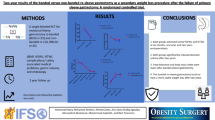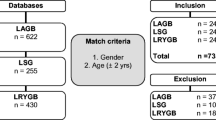Background: Laparoscopic adjustable gastric banding (GB) is the most popular restrictive procedure for obesity in Europe. Isolated sleeve gastrectomy (SG), is less common, but more invasive and with a higher learning curve. The aim of this prospective randomized study was to compare the results of GB and SG after 1 and 3 years of surgery. Methods: 80 patient candidates for laparoscopic restrictive surgery were operated consecutively and randomly, between January and December 31, 2002, by GB (7M, 33F) or by SG (9M, 31F) (NS). Median age was 36 (20-61) for GB versus 40 (22-65) for SG (NS). Median BMI was 37 (30-47) for GB versus 39 (30-53) for SG (NS). After 1 and 3 years: weight loss, feeling of hunger, sweet eating, gastroesophageal reflux disease (GERD), complications and re-operations were recorded in both groups. Results: Median weight loss after 1 year was 14 kg (−5 to +38) for GB and 26 kg (0 to 46) for SG (P<0.0001); and after 3 years was 17 kg (0 to 40) for GB and 29.5 kg (1 to 48) for SG (P<0.0001). Median decrease in BMI after 1 year was 15.5 kg/m 2 (5 to 39) after GB and 25 kg/m2 (0 to 45) after SG (P<0.0001); and after 3 years was 18 kg/m2 (0 to 39) after GB and 27.5 kg/m 2 (0 to 48) after SG (P=0.0004). Median %EWL at 1 year was 41.4% (−11.8 to +130.5) after GB and 57.7% (0 to 125.5) after SG (P=0.0004); and at 3 years was 48% (0 to 124.8) after GB and 66% (−3.1 to +152.4) after SG (P=0.0025). Loss of feeling of hunger after 1 year was registered in 42.5% of patients with GB and in 75% of patients with SG (P=0.003); and after 3 years in 2.9% of patients with GB and 46.7% of patients with SG (P<0.0001). Loss of craving for sweets after 1 year was achieved in 35% of patients with GB and 50% of patients with SG (NS); and after 3 years in 2.9% of patients with GB and 23% of patients with SG (NS). GERD appeared de novo after 1 year in 8.8% of patients with GB and 21.8% of patients with SG (NS); and after 3 years in 20.5% of patients with GB and 3.1% of patients with SG (NS). Postoperative complications requiring re-operation were necessary for 2 patients after SG. Late complications requiring re-operation after GB included 3 pouch dilations treated by band removal in 2 and 1 laparoscopic conversion to Roux-en-Y gastric bypass (RYGBP), 1 gastric erosion treated by conversion to RYGBP, and 3 disconnections of the system treated by reconnection. Inefficacy affected 2 patients after GB, treated by conversion into RYGBP and 2 patients after SG treated by conversion to duodenal switch. Conclusion: Weight loss and loss of feeling of hunger after 1 year and 3 years are better after SG than GB. GERD is more frequent at 1 year after SG and at 3 years after GB. The number of re-operations is important in both groups, but the severity of complications appears higher in SG.
Similar content being viewed by others
Author information
Authors and Affiliations
Rights and permissions
About this article
Cite this article
Himpens, J., Dapri, G. & Cadière, G.B. A Prospective Randomized Study Between Laparoscopic Gastric Banding and Laparoscopic Isolated Sleeve Gastrectomy: Results after 1 and 3 Years. OBES SURG 16, 1450–1456 (2006). https://doi.org/10.1381/096089206778869933
Published:
Issue Date:
DOI: https://doi.org/10.1381/096089206778869933




